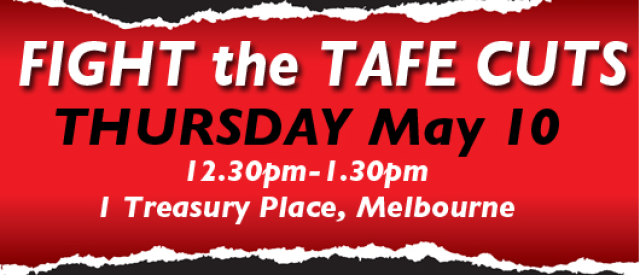
As part of savage budget cuts, the Victorian Coalition government has slashed $300 million over four years of funding for the provider of public technical and further education, the state’s 18 TAFE institutes that teach about 400,000 students a year.
Funding per student in 80% of courses has been cut from about $8 per training hour to as low as $1.50 - to a range meant to reflect labour market priorities.
Trades apprenticeships, aged care and child care received some small increases.
But the government cut the extra funding TAFEs received compared with private providers. This funding previously recognised their community role and obligation to provide non-profitable courses.
Student fees have also risen for all courses. If students who already have a degree or diploma undertake further study at an equal or lower level, they must now pay full fees.
Multiple qualifications at all levels is an increasing need as bosses demand that all the skills development they profit from is paid for by the public or by workers.
Education unions have warned of the loss of thousands of jobs and the danger of imminent collapse of some providers, such as the highly regarded William Angliss Institute, a unique public specialty provider of training in hospitality, one of the hardest hit areas.
“These cuts are a mark of this government’s attacks on the vulnerable in society,” Mary Bluett, Victorian president of the Australian Education Union (AEU), which represents TAFE teachers, told Green Left Weekly.
“We’re receiving increasing support from other unions, from Trades Hall and community organisations for the campaign we’ve launched. The first step is a rally next Thursday, May 10, at Treasury Gardens.”
The National Tertiary Education Union (NTEU) is also involved, representing non-teaching staff at TAFEs as well as all staff in higher education, including the higher education divisions of Victoria’s five dual sector universities.
These universities have played an important role in raising access to all levels of tertiary education through pathway programs. Jeremy Smith, NTEU branch president at Ballarat University and Socialist Alliance member, told GLW the hits to the TAFE divisions of these universities will undermine this role.
“This budget sends the worst messages about the kind of society the Liberals envisage: $1 billion extra for prisons and devastating cuts to public vocational education.”
“The loss of these precious community institutions would be terrible for regional communities.”
Regional funding has also been slashed from 22% to 5% loading. Bluett said the AEU will organise a tour to build support for the anti-cuts campaign.
Smith also noted that the latest cuts were a direct continuation of the former Brumby Labor government’s TAFE marketisation policies.
Public funding was made available to private providers from 2009, leading to an explosion of often dubious quality providers, the diversion of more public funds to the private sector and pressures on TAFEs to compete with providers with poorly paid staff and none of the community obligations of TAFE.
The Labor government also introduced fees for TAFE in 2005.
Margarita Windisch, AEU activist at the TAFE division of Victoria University and Socialist Alliance member, told GLW: “The rally on May 10 is a good start and a big turn out will show that the community is outraged.”
However, she said education unions should recognise that “one rally is not enough. This protest needs to be followed up with strikes, pickets, petitions, public meetings — essentially a mass campaign that involves students, staff and the broader community.
“Now more than ever is the time to show leadership and courage.”
[For more information visit the website. A “Fight the TAFE cuts” rally will take place on May 10 at 12.30pm at the Premier's office, 1 Treasury Place, Melbourne.]
Comments
Anonymous replied on Permalink